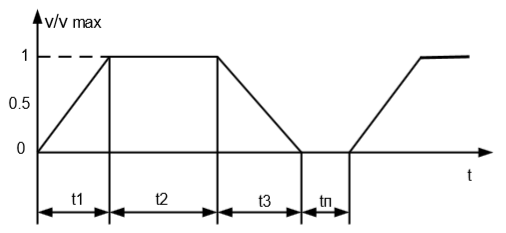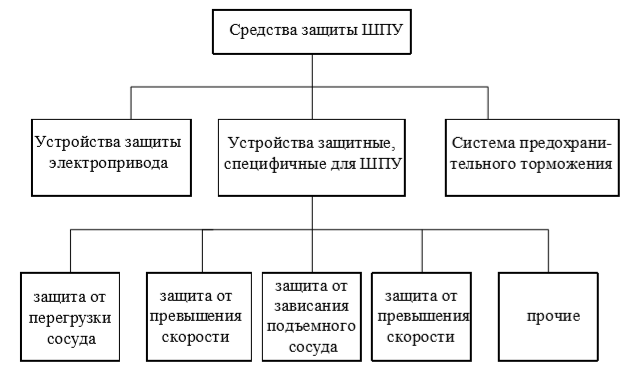Abstract
Contents
1. Introduction
The operation of the lifting installation is characterized by cycling, i.e. next alternating cycles, following each other. In turn, each cycle can be divided into four main periods: acceleration, uniform motion, deceleration to a complete stop and a pause. Thus, in order to ensure the required productivity of the mine rise, each cycle must fit into a certain, predetermined time. To do this, it is necessary to withstand the calculated values ??of acceleration and deceleration, the maximum speed and duration of the pause, i.e. maintain the adopted speed chart. When carrying out lifting operations, the speed of the lifting engine should be changed according to a certain law, characterized by a speed diagram (Fig. 1.1). Fig.1.1 shows t1-acceleration time, t2 - time of movement with uniform speed, t3 - time of deceleration, tп - duration of pause. It is possible to ensure the accuracy of its development by means of automated electric drive control systems.

Figure 1.1 - The speed diagram of the mine lifting installation
This requires the reliable operation of the drive. There are very high demands on the electric drive, one of the points of which is to monitor the health of individual elements of electrical equipment and to protect against disturbances in the normal operation of the electric lift in accordance with the requirements PB and technological requirements that are given in / 14 /.
The increased requirements for protection devices can be met not only by increasing the complexity of the equipment, but also by expanding their functionality. Fig. 1.2 shows the classification of the protection of mine hoisting installation (silo). It follows from it that, in addition to devices specific to silos and safety braking systems, electric drive protection devices occupy one of the leading places. A very important role in the protection system is assigned to the thermal control system.

Figure 1.2 - Classification of protection mine shaft installation
Characteristic modes in which the failure of electric motors is most often observed are: hoisting of lifting vessels, their overload, and also modes of a prolonged start. This dramatically increases the current, and, consequently, the temperature
In addition, the analysis of the operating modes of the electric skip hoist drives shows that they are close to the modes classified by GOST 183-74 as S2 ... S5 (short-term and intermittent-short-term). The operation of asynchronous motors (BP) in short-term operation modes S2 ... S5 is associated with a number of features that are of considerable practical importance.
2. Objective
The electronic diagnostics system of the electric skip hoist electric drive is intended for the diagnostics of the electric motor of type AKK, control of technological parameters, alarm, protection from emergency situations and is a further development of the existing thermal control system.
The system should provide:
- centralized collection of information;
- processing and accumulation of information about the state of the electric motor;
- submission of information to operational production personnel;
- signaling deviations of monitored parameters for specified limit values;
- modernization of existing motor diagnostics systems;
- increase the stability of the automation system;
- increase of reliability of control, protection and regulation of parameters;
- acceleration of search in case of emergency situations for their elimination;
3. Automation object and its features
According to GOST 183-74, the short-term mode S2 means the operation of an electric machine with a constant load of 10, 30, 60 or 90 minutes duration (unless another one is set in standards or technical conditions) / 15 /. In catalogs, as a rule, the nominal capacities are indicated with durations of 30 and 60 minutes. This is followed by a long pause, for which the temperature of the active parts of the machine should be reduced to almost the initial level. In this mode, within the core of the HELL, the temperature constantly changes over time. There are two transients: heating (under load) and cooling (with a stationary rotor). The amount of heat released in the active parts of the electric machine is equal to the sum of the accumulated thermal energy in the structural elements and discharged into the environment. In this case, the maximum temperature in the windings should not exceed the maximum permissible for the corresponding class of insulation. From this it follows that with a shorter on-time, the load of the electric machine may be higher, and the thermal transition process will proceed more intensively and higher temperature gradients will occur. In the catalogs of machines operating in short-term modes of operation, indicate the nominal parameters for the corresponding on-time, in which the temperature of the windings does not exceed the permissible in the hottest part of the insulation of the windings.
A number of factors affect the increase in current, and, consequently, temperature: load on the motor, rotational speed, change in the mains voltage, damage to the windings, etc. We give them a brief analysis.
It is known that with increasing load the speed of rotation decreases. As will be shown below, in this case a very important indicator is the heat transfer coefficient (CTO). One of its components is speed, which affects the conditions of cooling nodes / 20 /.
Reducing the voltage by 10% leads to a slight increase (within 3-9%) of temperature in the nodes. However, a further decrease in voltage leads to a greater increase in temperature (especially in the rotor and the temperature of the internal air) by 23-28%. Which leads to the redistribution of the temperature field of blood pressure. So at nominal mode, the most heated part of the arterial pressure is the frontal part of the stator winding. When the voltage drops by 20%, the groove part of the rotor winding becomes the most heated part of the engine. The temperature of the stator at the same time increases by an average of 14%, and the temperature of the rotor - by 25-26% / 21 /.
The breakage of one of the parallel branches causes a non-symmetry of the currents and leads to an uneven distribution of temperatures in the nodes of the stator windings and increased temperature loads. The most heated part is the front part of the intact branch of the stator winding of the phase in which the breakage of one of the branches occurred. When the engine is running with a broken parallel branch of the stator winding. The frequency of rotation varies slightly. In order to avoid overheating, it is necessary to reduce the engine load. With the help of panel instruments, it is difficult to identify such a malfunction / 22 /.
Based on the results of studying the operating modes of the engines, as well as as a result of the analysis of the operation of the applied means of protection of electric motors, it was concluded that an integrated approach is needed to solve the problem, i.e. along with the development of the motor protection device itself, it is necessary to constantly monitor and predict the main cause of engine damage - the thermal state of the insulation of the motor windings and the associated service life, the rate of temperature change, rotational speed, voltage
To build thermal control systems, it is necessary:
Develop a methodology for predicting the residual service life of motor insulation.
Analyze various methods of calculating the temperature and choose the most appropriate one to solve the problem..
Develop a thermal scheme for replacing the engine and its mathematical description.
Calculate all values for steady-state and dynamic modes included in the mathematical description.
Develop an algorithm for solving the task and execute its software implementation.
Findings
As a result of the work performed, the level of automation and reliability of the lifting machine drive.
At the time of writing this essay the master's work is not yet completed. Final Completion: June 2019. Full text of the work and materials on the topic can be obtained from the author or his manager after the specified date.
List of sources
- А.с. 197734 СССР, МКИ3 НО2 Н7/0852. Тепловой аналог электродвигателя / М.З. Дудник, В.Е. Михайлов, В.Г. Паркесов, Н.Н. Соломченко (СССР).- 2959370/24-07; Заявлено 18.07.80; Опубликовано 15.06.82. Бюл. № 22.
- А.с. 936187 СССР, МКИ3 НО2 Н7/085. Тепловой аналог электродвигателя / М.З. Дудник, В.Е. Михайлов, В.Г. Паркесов, Н.Н. Соломченко (СССР).- 2959370/24-07; Заявлено 18.07.80; Опубликовано 15.06.82. Бюл. № 22.
- A.с. 1001294 СССР, МКИ3 НО2 Н7/085 Тепловой аналог электродвигателя / М.З. Дудник, М.М. Федоров, В.Е. Михайлов, В.П. Мариночкин (СССР).- 3323239/24-07; Заявлено 22.07.81. Опубликовано 28.02.83. Бюл. № 8.
- A.с. 1089692 СССР, МКИ3 НО2 Н7/08 Устройство для тепловой защиты электродвигателя / М.З. Дудник, М.М. Федоров, В.Е. Михайлов, В.П. Мариночкин (СССР).- 3559202-07; Заявлено 28.02.83. Опубликовано 30.04.84. Бюл. № 12.
- A.с. 108328 СССР, МКИ3 НО2 Н7/08 Устройство для тепловой защиты электродвигателя / П.П. Кузьмин, П.Н. Новиков, В.А. Шамшин (СССР).- Опубликовано 28.05.84. Бюл. № 12/
- Богуславский П.С. Позисторы - свойства и применение. // Электротехника, 1967.- №5.- с. 14-15
- Борисенко А.И., Данько В.Г., Яковлев А.И. Аэродинамика и теплопередача в электрических машинах.- М.: Энергия, 1974.- 560с.
- Кашпар Ф. Термобиметаллы в электротехнике.- М.: Госэнергоиздат, 1961.- 448 с.
- Котеленец Н.Ф., Кузнецов Н.Л. Испытания и надежность электрических машин. М.: Высш. шк., 1988.- 323 с.
- Линевег Ф. Измерение температур в технике. Справочник. Пер. с нем. М.: Металлургия, -1980.- 544 с.
- Минкин С.Б., Шашков А.Г. Позисторы.-М.: Энергия, 1973.- 89 с.
- Основы теорй цепей / Зевеке Г.В., Ионкин П.А., Нетушил А.В., Страхов С.В.- М.: Энергия, 1975.- 752 с.
- Панферов М.М., Цыбин А.А., Кузнецов Л.М. Тензорезисторные измерительные системы // Приборы и системы управления. 1985.-№9. С.17-21.
- Малиновский А.К. Автоматизированный электропривод машин и установок шахт и рудников: Учебник для вузов. – М.: Недра, 1987.- 277 с.
- Сипайлов Г.А., Санников Д.И., Жадан В.А. Тепловые, гидравлические и аэродинамические расчеты в электрических машинах.- М.: Высшая школа, 1989.- 240 с.
- Математические задачи теплопередачи в электрических машинах. / Счастливый Г.Г., Бандурин В.В., Остапенко С.Н.- Киев: Наукова думка, 1986.- 184 с.
- Шефтель И.Т. Терморезисторы / М.: Наука, 1973.- 415 с.
- Федоров М.М., Рак А.Н. К вопросу о прогнозировании остаточного срока службы изоляции электрических машин // Известия ВУЗов. Электромеханика. - 1997 - №1-2.- С. 6-8.
- Рак. О. Прогнозування залишкового терміну служби ізоляції обмоток електродвигунів // Вісник Державного університету “Львівська політехніка”. Проблеми економії енергії № 2. Львів: ДУ “Львівська політехніка”.-1999.- С.7376.
- Проектирование электрических машин: Учеб. Пособие для вузов/ И.П. Копылов, Ф.А. Горяинов, Б.К. Клоков и др. Под ред. И.П. Копылова.- М.: Энергия, 1980.- 496с., ил.
- Федоров М.М., Алексеев Е.Р. Тепловое состояние асинхронных двигателй при изменении напряжения сети / Збірник наукових праць ДонДТУ. Серія: ”Електротехніка і енергетика”, випуск 17: Донецьк: ДонДТУ, 2000.- С.82-86.
- Федоров М.М., Денник В.Ф. Тепловое состояние электродвигателей переменного тока при обрывах параллельных ветвей статорных обмоток / Збірник наукових праць ДонДТУ. Серія: ”Електротехніка і енергетика”, випуск 17: Донецьк: ДонДТУ, 2000.- С.87-91.
- Надежность электрооборудования угольных шахт / Б.Н. Ванеев, В.М. Гостищев, В.С. Дзюбан и др.; Под ред. А. И. Пархоменко. –М.: ОАО «Издательство «Недра», 1997. –302 с.: ил.
- Электротехнический справочник: в 3-х т. Т.2. Электротехнические изделия и устройства/ Под общ. ред. профессоров МЭИ (гл. ред. И.Н. Орлов) и др.- 7-е изд., испр. и доп.- М.: Энергоатоиздат, 1986.-712 с.: ил.
- Измерение электрических и неэлектрических величин: Учеб. Пособие для вузов./ Н.Н. Евтихеев, Я.А. Купершмидт, В.Ф. Папуловский, В.Н. Скугоров; Под общ. ред. Н.Н. Евтихеева.- м.: Энергоатомиздат. 1990.- 352с.: ил.
